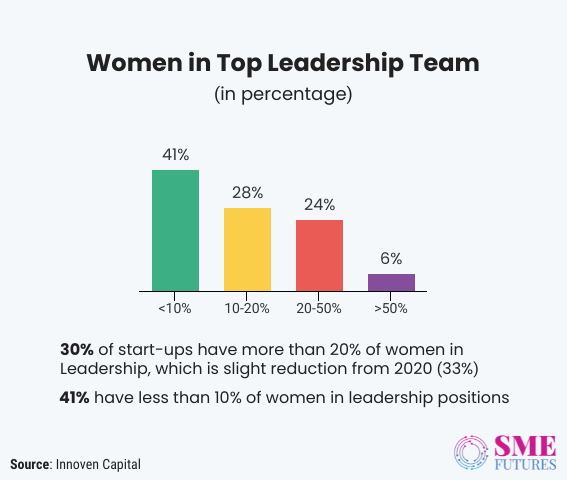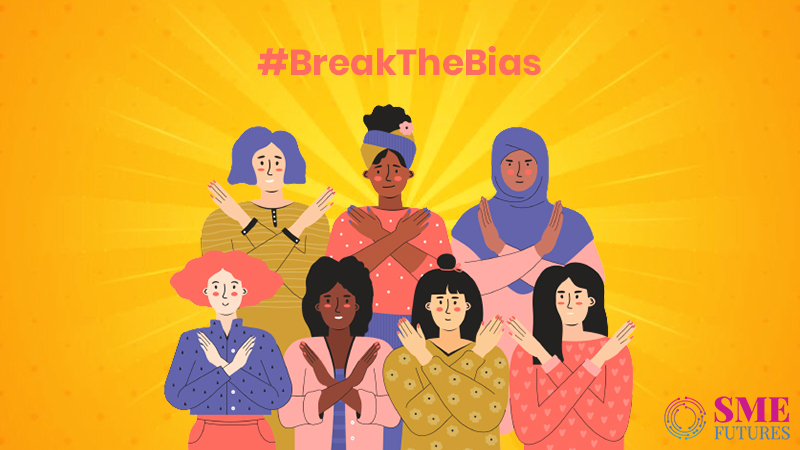“Did you know, our constitution provides for gender equality. In addition to this, several different legislations have been enacted such as the act aimed at the prevention of sexual harassment at the workplace,” I exclaimed while talking to Grusha Khanna, a friend of mine.
What’s the use!! she said while letting out a frustrated sigh. “There are times, when professionals like us have to deal with some sort of bias or obligation or both, be it in our personal or professional lives. Just look at the prevailing salary structures, the gender gap is glaringly obvious there. The PR fraternity comprises of a majority of female employees and yet they have to deal with such challenges at one point or the other during their professional trajectories in their organizations,” laments Grusha who works as a PR professional and is no stranger to the glass ceiling herself.
This is not the first time that anyone is talking about the inherent gender bias in society. It has been and continues to be a hotly debated topic among peer groups and on various forums. The topic has been highlighted and discussed at the UN as well. It is just a fact of life that countless women continue to deal with even in this day and age.
Our brains are hardwired
Individually, we’re all responsible for our own thoughts and actions – all day, every day. And now it’s time to think about gender biases. For many years now, India, as a patriarchal society, has struggled with these issues. Because our brains are hardwired to see things in a certain way. Furthermore, it’s often labelled as ‘sexism’.
“Standing in the 21st Century, women are still fighting for their rights regarding equal pay, equal benefits and equal opportunities at the workplace,” says Megha Beriwala, VP-Marketing at Shyam Steel.
This discrimination is reflected in people’s nuanced mannerisms and subtle interactions.
“This is not only visible in Indian corporations but exists globally. People unknowingly partake in discriminatory practices, as that is how they’ve always seen other people think and act around them and assume that to be normal and don’t question it,” shares Beriwala.
Despite changing norms and women becoming changemakers, whether deliberate or unconscious, this bias still makes it difficult for women to move ahead. It is the kind of inherent bias that disproportionately affects most women’s success in the workplace.
Let’s digest these statistics gathered by Linkedin’s Opportunity Index 2021.
Working women in India face the most gender bias of any Asia Pacific (APAC) country.
More than 4 out of every 5 working women (85 per cent) say that they have been passed over for a raise, promotion, or job opportunity because of their gender.
Over 7 in 10 working women and working mothers believe that family responsibilities frequently obstruct their career advancement.
In fact, about two-thirds of working women (63 per cent) and working mothers (69 per cent) said they have faced discrimination at work because of their familial and household responsibilities.
According to a LinkedIn official, gender inequality at work and the added domestic responsibilities amid the pandemic have collectively made women’s jobs more vulnerable at this time. But one thing needs to be remembered…that it’s always been like this! Women have always been the soft targets. We can’t lay the blame for this at the pandemic’s door. It has just exacerbated and exposed the problems that were already there.
Furthermore, women in leadership are still not at par. A recent report by Innoven Capital highlighted the gender disparity in start-ups. Look at the numbers here.

Clearly the statistics indicate that the need of the hour is for the organisations to re-imagine their diversity practices and offer greater flexibility to caregivers to increase female participation in their workforce.
That’s one thing to do. Meanwhile, I spoke to many female industry leaders and entrepreneurs to get a comprehensive understanding of what they think of the gender bias issues as old habits die hard.
Most organisations having a male majority can potentially make it difficult for women in a variety of situations- recruitments, promotions, recognition of leadership potential, career advancement- indeed, in all facets of life at the workplace.
Everyone has gone through it
Talking about these experiences can be overwhelming. But women are opening up more now on many controversial topics. And gender bias is one of them. And it is obvious that a lot of female professionals have experienced it.
“I’ve been called too young, too good looking, too single!!!! I’ve been hit on by bosses and colleagues alike. I’ve been mocked for not being top notch at finances and looked at amusedly and referred to as a ‘little girl’,” reveals Anika Parashar, CEO and founder of The Woman’s Company (TWC).
The comments get more and more ludicrous as she further opens up.
“I’ve been told that my perfume is too strong, that my husband left me because I was too focused on work,” why was it anyone’s business to comment on this? she questions.
“I’ve heard whispers that I slept my way to the top. This happened all the while I was raising my kids single handedly, dealing with a sick mother and trying to meet my targets – I didn’t have time to sleep with anyone,” she exclaims.
Snide and sexist remarks like these have the potential to shatter anyone’s confidence.
Also sharing her experiences, Aakanksha Bhargava, CEO of PM Relocations tells us that her entire journey is a testament to the fact of facing and overcoming the gender bias. Because the business that she is a part of is a male dominated one, where the prevailing viewpoint is that men do better in it as it is their area of expertise.
“In the initial days, during visits to Bangalore for pre-move surveys, I was often asked as to how I would do this job alone, whether the packers would listen to me and that I was too young to be doing the surveys. Similarly, I had to face apprehensive customers who would ask if I would be doing the pre-move survey correctly and that they would have expected a man to come and do this for them,” she shares.
Archanna Das, who heads Ascent Foundation, has in her 20-year career witnessed gender bias personally on multiple occasions. “I faced stereotyping about being a woman, looking a certain way, handling jobs that are men-centric, etc. and in some way or the other still continue to experience it,” she weighs in.
However, she also feels that the environment has become much better compared to what it was when she started. “I am positive we are on the right path in attaining gender inclusivity at the workplace,” she says.
And we hope for the same but the truth is far from it.
Women leaders must prove themselves
Generally, women are stereotyped as slow workers, as less hardworking, as not focused enough, and as less goal oriented.
People assume that females won’t be sticking to a particular job for long, as their ultimate goal in life is to marry and get settled. As a result, women professionals are offered lesser pay, fewer benefits and fewer opportunities at the workplace.
“Simply put, they need to prove their worthiness,” says Beriwala.
Women being a minority in workplaces, even more so in leadership roles, face numerous situations. Sometimes these are reflected in small things, such as attending a meeting with male colleagues and seeing that all the conversation, and even eye contact, is directed at them. Or being interrupted by people speaking over them. Or when subordinates prefer to take directions from their male counterparts. Other examples relate to career limiting factors, such as finding it difficult to have their views heard or being passed over for promotions.
“As a senior leader, at times I feel the pressure to prove myself way more than my male counterparts,” comments Vinny Sharma, Marketing Director-Asia Pacific & Middle East at Securonix.
“It will not be an exaggeration to say that women still have to put in a lot more effort in their jobs to gain respect from their colleagues, even from their juniors. When a senior woman leader puts forth any ideas, people are more likely to oppose it vis-à-vis when a male leader is involved. The only way one can deal with it is by being confident and decisive. These prejudices are not going to go away easily, and we have to find a way to address them in an appropriate manner,” she adds.
This may also cost women bosses their likeability factor—Just watch The Devil Wears Prada.
In other words, a woman leader must assert herself much more strongly than a male leader in order to be listened to, says Dr Rashmi Sharma – Head, Webel Fujisoft Vara Centre of Excellence, who comes with years of experience in her field and has dealt with such issues first hand.
“This comes at the cost of likeability, and this presents as a huge issue for women as well as being something that has significant ramifications for their career progression, as she is seen as “difficult” or “over-assertive” or ”less competent”. Sheryl Sandberg writes about this, saying that successful men are well-liked but when a woman is successful, she is less liked. In my view, this rings true,” she says.
Why are we still dealing with it?
Once again, the answer lies in our roots and the way that we think.
To understand this better, Pew Research recently did a survey on how Indians viewed gender roles. Needless to say, the patriarchal mindset shone through in the responses that they received.
For instance, many Indians (43 per cent) view earning money as mainly the obligation of men. And Indian adults overwhelmingly say that when jobs are in short supply, men should have greater rights to employment than women, reflecting the continued prominence of men in the economic sphere. Eight-in-ten agree with this sentiment, including a majority (56 per cent) who completely agree.
“Unfortunately, our brains are hardwired right from childhood to think and perceive the gender dynamics the way they are. Something as simple as categorising toys based on the gender of the child and telling them what to play with, forms the bias which is carried forward to adulthood,” says Bhargava of PM Relocations.
Globally too, there are many different societies and cultures which define what a woman should do and what a man should do.
TWC’s Parashar thinks that gender discrimination is a pervasive issue. From foetal selection to inheritance to job opportunities, the gender bias has been perpetuated in society since time immemorial, she says.
“Some of the reasons for it in India are the patriarchal systems in households, illiteracy, the transfer of household responsibilities, the lack of awareness among the masses, the lack of confidence among women, and several male stereotypes being blindly propagated all the time,” she elaborates.
Sharma of Securonix believes that there are unconscious and conscious gender biases at workplaces owing to the long history of internalising patriarchal norms. There is also a huge disparity between the company’s growing commitment to gender equality and the lack of improvement we see in the day-to-day experiences of the women who work for them.
“Gender stereotypes exist because of the norms set by society. Women are held responsible for taking care of children, looking after the elderly and managing the housework. In fact, women themselves feel guilty if they fail to fulfil their ‘duties’. Therefore, a lot needs to be done to close the gender gap. To realise the benefits of an inclusive and diverse workforce, business leaders need to take active and intentional steps to ensure gender equality,” she comments.
Gender equality is critical in boardrooms
Let’s focus on another area, where women need to buck up—in the boardroom.
The Companies Act 2013 has been a catalyst for increasing women representation on the boards of companies. However, the pace of change remains slow.
As per the seventh edition of Deloitte Global’s Women in the Boardroom report, women held 17 per cent of the board seats in India in 2021- an increase from 11.4 per cent in 2015. However, the number of women serving as board chairs has reduced. What is also significant is that women are less likely to be on important board committees.
“These numbers aren’t enough. Firms must understand the importance of gender inclusion at the middle and top levels, the lack of which exerts a negative influence on productivity and profitability and spoils the culture of a company,” says Parashar.
Beriwala too opines that the strong representation of women in the boardroom is crucial as they defy various odds and overcome gender disparities at various levels to reach there. “It is high time that the realization should set in. In the current scenario, women are taking charge and leading various spheres, but we still have a long way to go,” she comments.
Sharma also weighs in, saying, “Gender diversity is a business imperative owing to the many benefits that accrue from it. A diverse mindset and approach are not only the right thing to do, but they also make good business sense because they bring in different perspectives and ultimately offer solutions that can best solve the customers’ problems.”
Measure gender diversity
All the women leaders we spoke to unanimously said that women are at par with their male counterparts in the business world in terms of education and specialisation. Therefore, to measure gender diversity, companies can look at five metrics: recruitment, pay or promotion, retention, advancement, and representation.
While this data can give a quantitative snapshot of the current scenario, it can also yield softer data (such as employee perceptions) that can give a bird’s eye view of the larger problems that the company’s need to address.
“Absolutely! Boardrooms are the place where it’s all visible and I think that the story is changing. There’s a lot of conversations happening around the whole concept of diversity, inclusion, and equality at the workplace. Which I feel is not enough but there is definitely a start, so that is the good news. I think at the end of the day, even if there is one woman in that boardroom meeting with an equal opportunity to speak and put her point across, that is a success!,” says Bhargava.
The way ahead for corporations
The only way ahead is to address the gender stereotypes and remedy the problems caused due to them to keep the talent pipeline flowing, say all the experts.
“Corporates are increasingly becoming aware of gender biases and acknowledging it makes it an area that needs improvement. One way to address the stereotyping would be to consider more women candidates for management and leadership roles for the experience and expertise that they bring to the table rather than focusing on their gender, their marital status or their motherhood,” comments Parashar.
“They should maintain an open dialogue for the employees facing such discrimination. Corporations should take initiatives to address the bias in the attitudes of people towards women,” says Beriwala.
Dr Sharma opines that organisations need to make a real and concerted effort to increase the number of their female employees and equally importantly, to increase the number of women in their senior and leadership roles. “There are many areas that I feel are important but here I will speak about only four: policy making, hiring, developing and sensitisation programmes,” she suggests.
While women-centric policies are important, the culture of an organisation plays a huge role during the journey to gender normalisation.
“Building awareness, creating inclusion, sensitising employees and scrutinising the language used by the leadership are a few of the processes that have been defined to deal with gender bias challenges, and they should be incorporated in every organisation to enable the culture of gender equality and inclusivity. SMEs/MSMEs should also realise that this is not a one-time implementation. The policies and cultures of organisations should evolve to be relevant with the changing ecosystem,” comments Das.
That goes for hiring as well.
For corporations to address gender stereotyping, it is important for them to have conversations and workshops to address their hiring needs. Several questions should be answered.
“The questions should be- What is the company looking out for? What is the company’s culture and more importantly what is the person’s skillset and the kind of performance they have had in the past and the kind of intent with which they are applying for the job? If we start aligning the right skillset to the job description, only then will we be able to address this issue and see the changes with respect to the gender bias and gender disparity at the workplaces,” says Bhargava.
Talent pipelines will continue to flow when all genders alike are considered, mentored, nurtured, and coached equally and so training programs and skill enhancement workshops should be offered to all genders.
Last but not least. How should a woman deal with the gender bias and gender stereotyping at her workplace? In the experience of the women leaders, it can be accomplished by doing a mixture of things.
Some things can be tackled with a mixture of assertiveness, patience and humour. “In my view, subtly and gently creating awareness is important- and effective,” says Dr Sharma.
However, there are some things that need to be addressed boldly. Not being afraid to have the conversations that are required is very important.
It is important to have people one can speak to in order to get different perspectives. And assistance when required. Therefore, seeking out and networking with other women in corporate roles and seeking women sponsors as well as women mentors is also very important.











